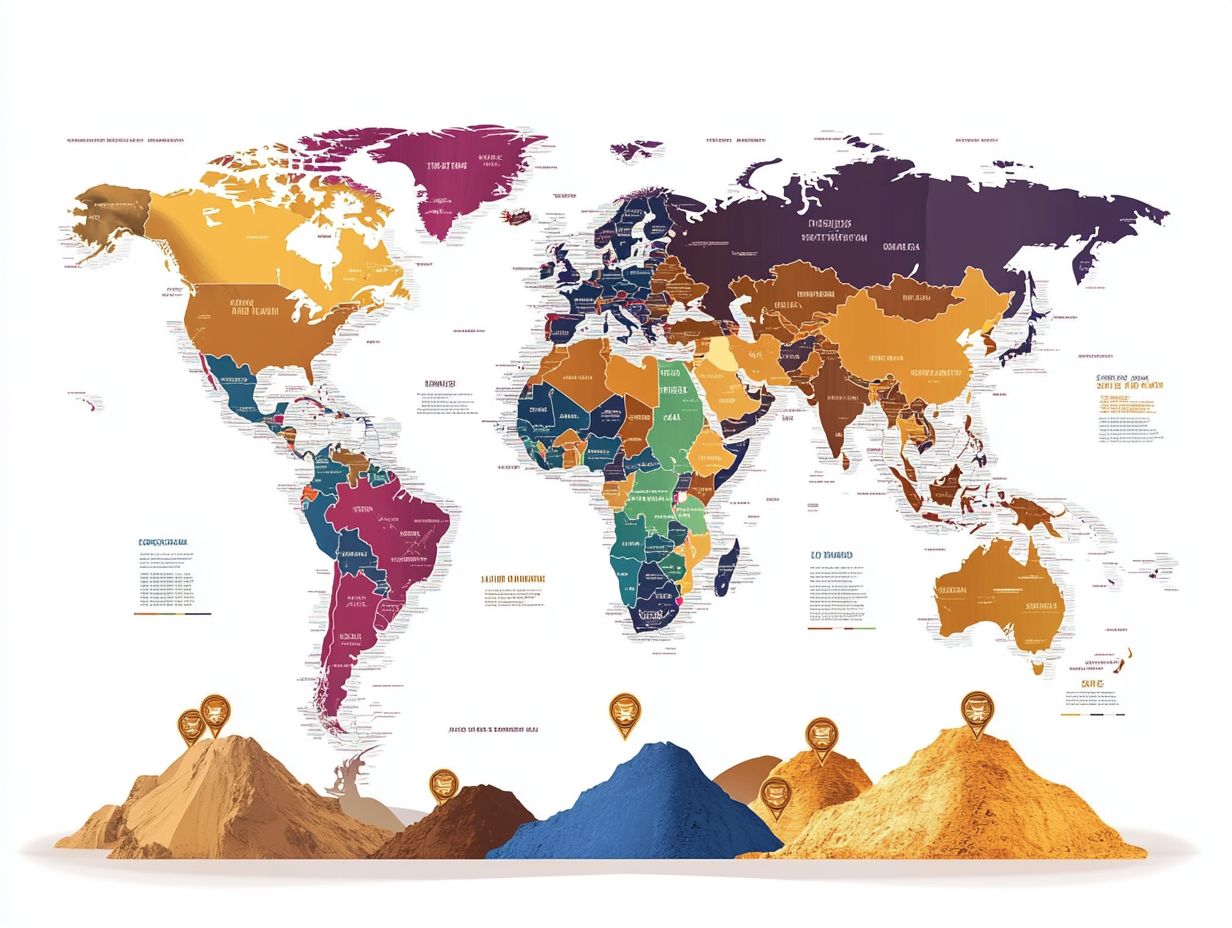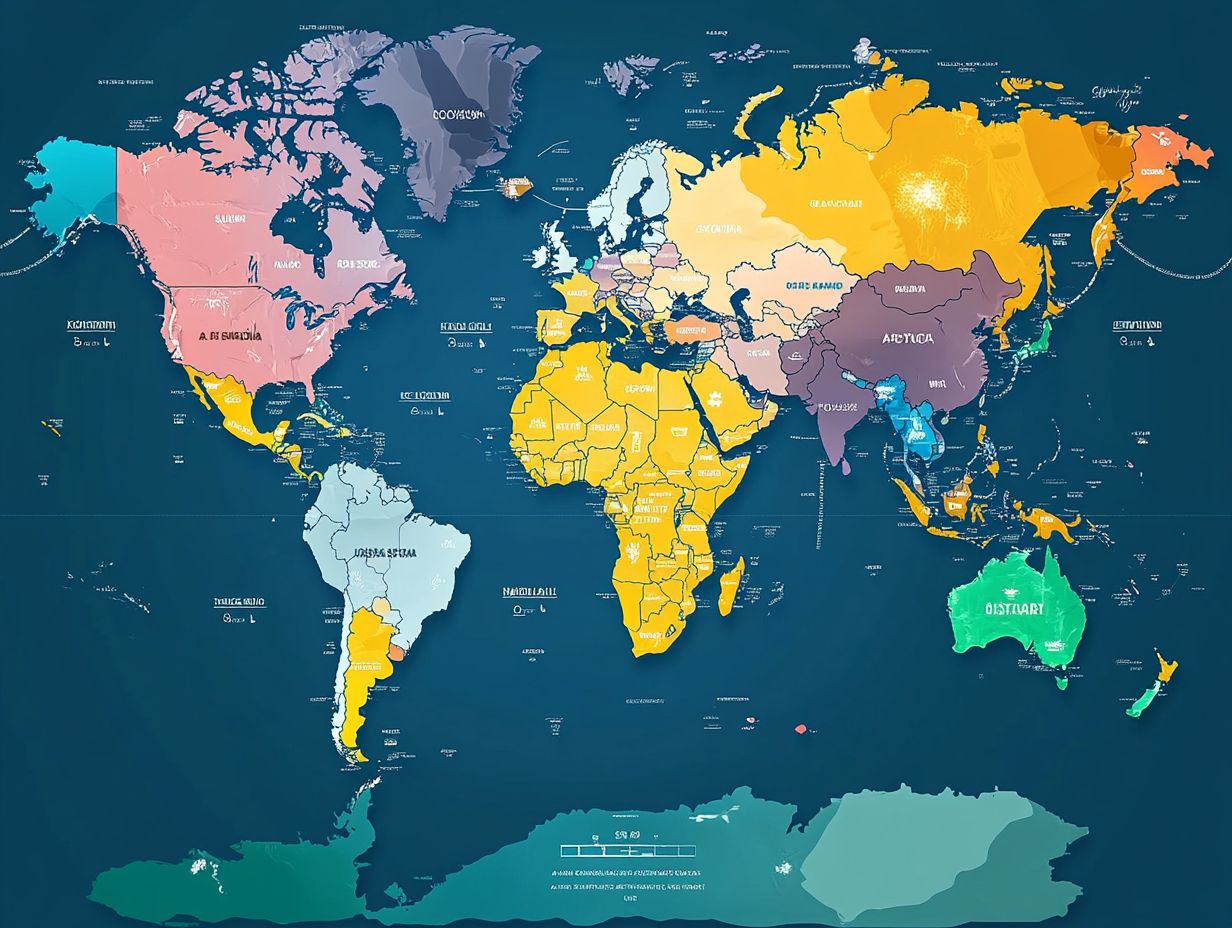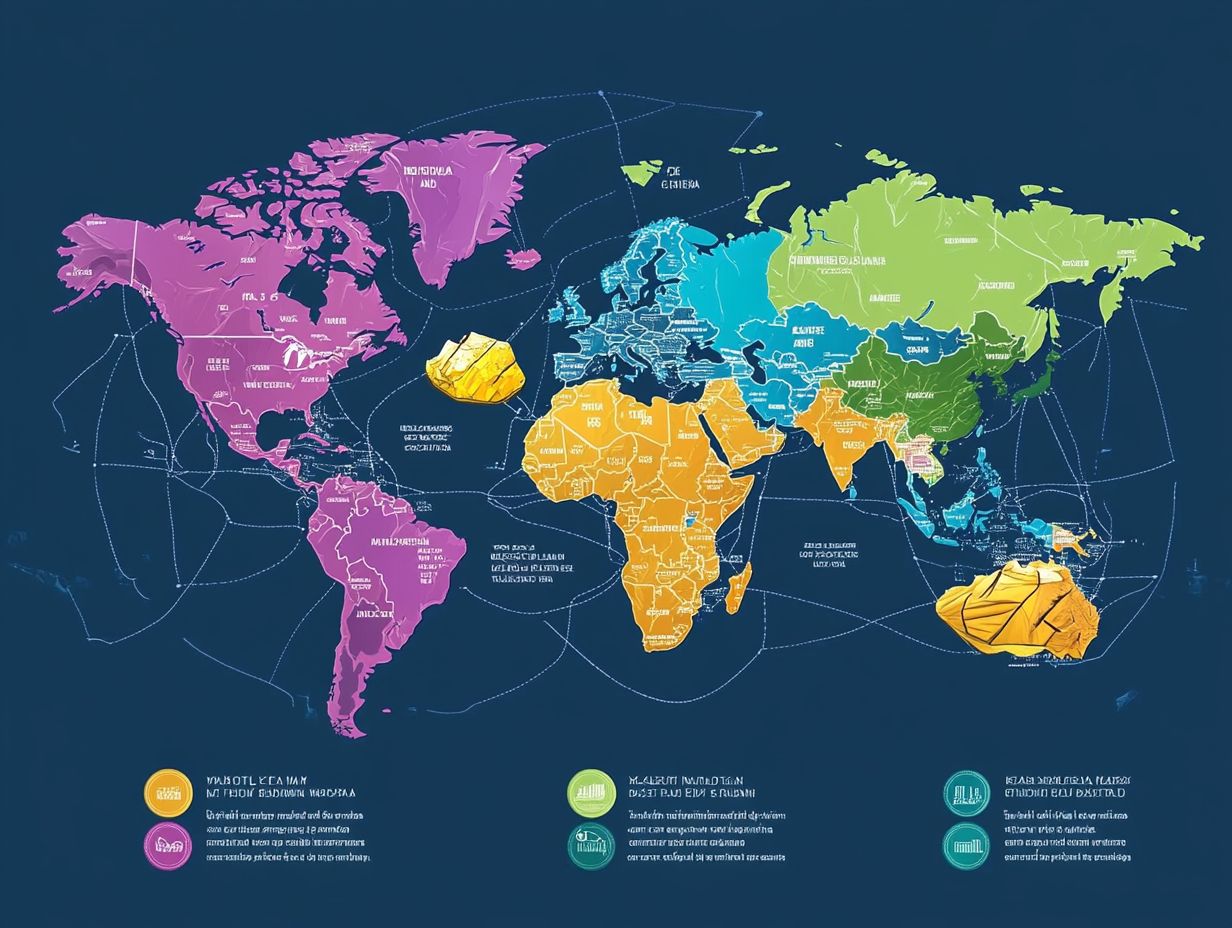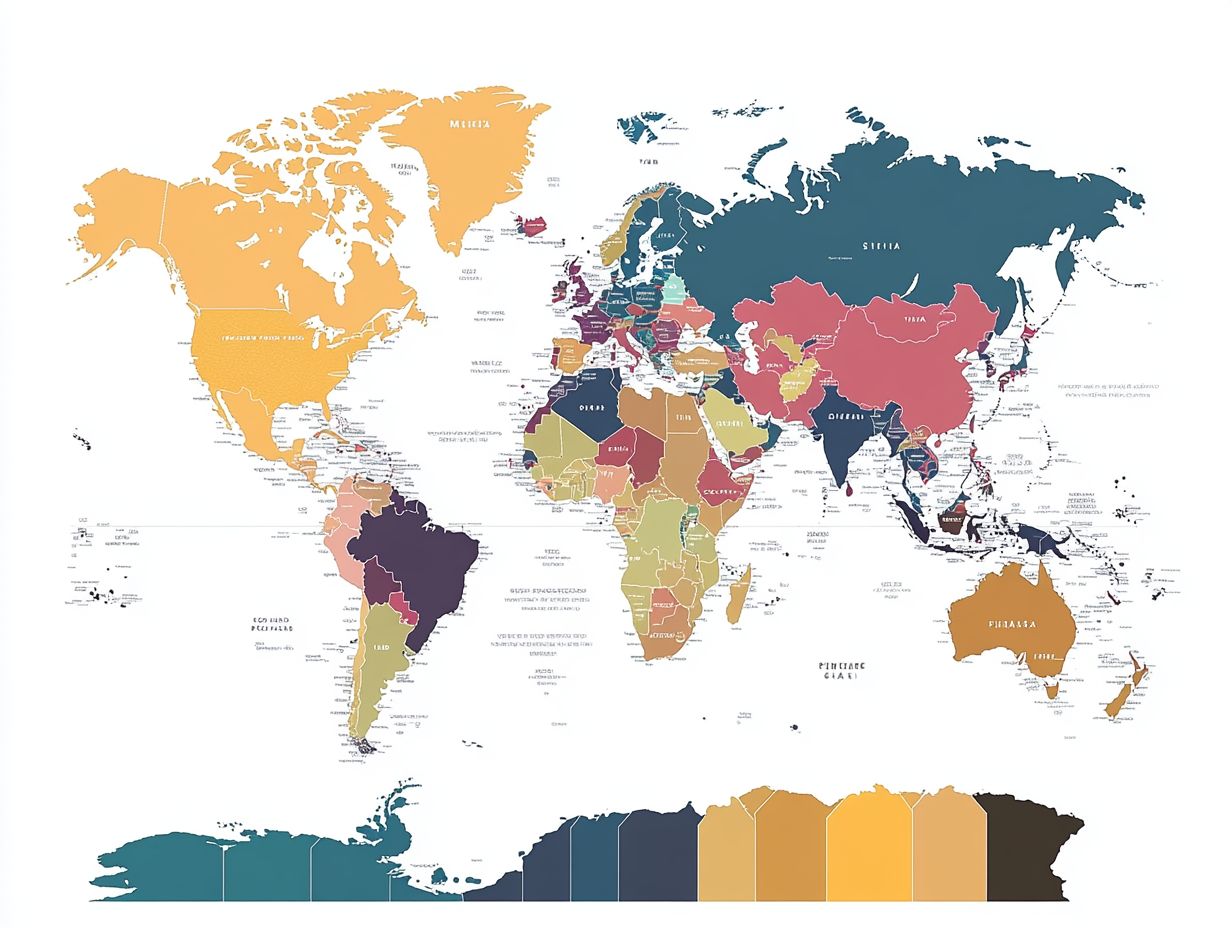The Top 5 Countries for Precious Metal Mining
Mining for precious metals is a vital industry, shaping economies and environments across the globe. This highlights the top five countries leading in precious metal mining: the United States, Australia, Russia, Canada, and South Africa. We explore the benefits these regions offer, from economic impacts to regulatory environments. We also discuss the environmental concerns and challenges faced by mining companies. Join us as we uncover what makes these countries stand out in the precious metals landscape.
Contents
- Key Takeaways:
- 1. United States: California
- 2. Australia: Western Australia
- 3. Russia: Siberia
- 4. Canada: Quebec
- 5. South Africa: Mpumalanga
- What Are the Benefits of Mining Precious Metals in These Countries?
- Frequently Asked Questions
- What are the top 5 countries for precious metal mining?
- How does Australia rank in terms of precious metal mining?
- Which country has the most silver mines?
- Are there any European countries in the top 5 for precious metal mining?
- What are some top companies in the United States for precious metal mining?
- Do all of the top 5 countries have mines for all types of precious metals?
Key Takeaways:

The top 5 countries for precious metal mining are the United States, Australia, Russia, Canada, and South Africa. Mining precious metals in these countries have various economic benefits, but also raises environmental concerns. Each country has different regulations and challenges for mining companies to navigate.
1. United States: California
California boasts a storied history in gold mining, playing a pivotal role in the United States’ overall gold production and establishing itself as a significant player in the global gold industry. The state’s diverse geological landscape presents an abundance of gold resources, enticing both state-owned and private operators in their quest for precious metals.
According to the US Geological Survey, California still shines brightly as a key player in gold production, underscoring its influence in today s gold prices and investment landscape. The Gold Rush of 1849 was a magnet for thousands of prospectors, leading to the creation of famous mines like Homestake Mine and Sutter’s Mill.
Fast forward to today, and California s gold production still ranks among the top states, though it faces fierce competition from leading nations like China and Australia, which hold the reins on global output.
While California is rich in resources, the gold industry grapples with environmental regulations that aim to strike a balance between economic growth and ecological preservation. These regulations shape mining practices, influencing operations while also promoting the sustainability of the state s natural landscapes an essential aspect of California s identity.
This commitment makes the booming gold sector both economically viable and ecologically responsible.
2. Australia: Western Australia
Western Australia stands as a true powerhouse in gold mining, earning its reputation as one of the premier gold-producing regions in the world. You ll find that it plays a pivotal role in Australia s impressive gold production and reserves.
The mining sector here is led by industry giants like Newmont and various state-owned operators, all engaged in gold smelting and extraction processes that not only boost the local economy but also cater to the global appetite for precious metals.
This bustling industrial landscape creates a wealth of job opportunities and stimulates a wide range of supporting businesses, from equipment suppliers to transportation services.
When you compare it to countries like China and Russia, which also have substantial gold reserves, Western Australia s gold production rates truly stand out, giving it a competitive edge.
As the industry shifts toward more sustainable practices in gold smelting, these operations are increasingly adopting advanced technologies aimed at minimizing environmental impact.
3. Russia: Siberia
Siberia is an essential region for gold mining in Russia, significantly influencing the country’s gold production and making waves on the global stage. With its abundant gold resources and the prominent role of state-owned operators, Siberia’s mining sector remains pivotal, especially amid political tensions between countries and fluctuating global gold prices.
The geographical spread of gold reserves throughout Siberia not only highlights the region’s mineral wealth but also presents logistical hurdles for extraction and processing. State-owned companies take the lead, skillfully utilizing their resources and infrastructure to tackle the complexities brought on by international sanctions and political tensions.
These political tensions may deter foreign investments, stifling economic growth relative to more stable and accessible mining environments like Canada and Australia. In these countries, the mining landscape enjoys established regulations and a more favorable investment climate, allowing them to remain competitive contenders in the global market.
4. Canada: Quebec

Quebec has become a significant hub for gold mining in Canada. It plays a vital role in the nation s gold production and supports a growing precious metals industry.
With a wealth of gold resources and prominent mining companies like Altyntau Kokshetau, Quebec stands out for its supportive rules and exciting investment opportunities.
In recent years, the province improved its rules to balance environmental protection and local economic growth. This commitment creates jobs and boosts the local economy.
Compared to other provinces, Quebec shows distinct advantages. It has abundant resources and a skilled workforce.
Recent initiatives show the government is collaborating with mining stakeholders. This dedication ensures that the gold sector can thrive in a challenging global environment.
5. South Africa: Mpumalanga
Mpumalanga, a cornerstone of South Africa, has carved its reputation through a rich history of gold mining that has profoundly shaped both the country’s gold production and its stance in the global market.
The presence of unions such as the Association of Mineworkers and Construction Union highlights the critical nature of labor relations within the gold industry. This is especially important as it navigates various challenges and reforms aimed at sustaining its valuable metals sector.
The region’s illustrious gold mining saga dates back to the late 19th century. It has influenced local economies and crafted a socioeconomic landscape that unveils the complexities of labor dynamics.
Recent production statistics indicate that while output may have seen its ups and downs, Mpumalanga continues to be a significant player in the global gold arena. Many stakeholders are eager to seize emerging opportunities.
However, the sustainability of this industry faces mounting threats from labor disputes and environmental concerns. Immediate action is needed to address these issues.
By exploring innovative mining techniques and enforcing stricter regulations, one can help mitigate these challenges. This will ultimately pave the way for a more sustainable future for this essential sector.
What Are the Benefits of Mining Precious Metals in These Countries?
Mining precious metals like gold presents you with a plethora of benefits, from significant economic impacts to enhanced global production capabilities. This creates invaluable resources in countries actively engaged in this sector.
Nations involved in gold mining see increased revenue generation, abundant employment opportunities, and remarkable technological advancements. All of these serve to propel their economies forward and bolster their status in the global gold industry.
Take Ghana, for example. Gold mining has made a substantial contribution to its national economy, generating over $2 billion in revenue annually while creating thousands of jobs, particularly in rural areas where employment options are scarce.
Similarly, Australia reaps the rewards of its gold mining sector through cutting-edge technologies that boost efficiency and prioritize environmental sustainability. Current statistics reveal that the gold mining sector supports around 20,000 direct jobs, fostering skill development and sparking innovation.
These economic advantages not only uplift local communities but also enhance the overall economic resilience of the nations involved.
Explore how you can invest in these thriving gold mining sectors today!
What Are the Environmental Concerns Surrounding Precious Metal Mining?
Precious metal mining raises considerable environmental concerns. This is particularly true for gold mining.
Issues like water pollution, habitat destruction, and the carbon footprint from gold smelting processes raise important questions about the sustainability of the gold industry.
For example, California’s gold rush legacy has left extensive mercury contamination that harms plants and animals.
In Australia, certain gold extraction practices threaten biodiversity, especially in regions rich in unique wildlife.
Meanwhile, vast gold mining operations in remote areas of Russia have led to significant ecological disruption, impacting soil and water quality.
Canada faces its own challenges, as mining encroaches upon Indigenous territories, resulting in conflicts over land use and environmental degradation.
To tackle these pressing issues, we could consider several potential solutions:
- Stricter regulations on emissions
- Implementation of sustainable mining practices
- Increased investment in eco-friendly technologies
All of these contribute to a more responsible approach to gold production.
What Are the Economic Impacts of Precious Metal Mining in These Countries?

The economic impacts of precious metal mining are profound. They influence national GDPs, job markets, and export revenues in countries engaged in gold mining, like the United States, Australia, Russia, and Canada.
As global gold production continues to rise, the importance of gold resources in local economies becomes increasingly critical.
This is especially true in regions with state-owned operators that drive significant investments.
The contributions of this sector are noteworthy, with many nations seeing boosts in job creation and overall economic activity.
However, while these benefits are substantial, challenges must not be ignored. Environmental degradation and volatile gold prices pose risks to the long-term sustainability of these economic advantages.
We must urgently discuss how to balance growth with responsible resource management!
How Do These Countries Compare in Terms of Regulations for Precious Metal Mining?
The regulatory landscape for precious metal mining is a patchwork of diverse frameworks. These differ dramatically from one country to another.
Each nation navigates the delicate balance of managing gold mining activities while addressing environmental, social, and economic considerations.
Take Canada, Australia, Russia, and the United States, for instance. Each brings its unique regulatory approaches to the table, profoundly influencing gold production and the overall vitality of their gold industries.
In Canada, stringent regulations prioritize environmental protection. Comprehensive assessments and community engagement ensure that potential ecological impacts are effectively addressed before mining operations begin.
Australia has strong laws that emphasize environmental rehabilitation and respect Indigenous land rights. This fosters equitable dialogue between miners and local communities.
In contrast, Russia’s regulatory framework is heavily influenced by state control, reflecting the nation s political factors and presenting investment challenges due to international sanctions.
The United States presents a complex mix of federal and state laws that can create inconsistencies, ultimately raising compliance costs for mining companies.
These varied regulatory approaches significantly shape investment strategies and production levels within the global gold market. It s essential for stakeholders to stay informed and adaptable.
Join the conversation about sustainable mining practices!
What Are the Challenges Faced by Mining Companies in These Countries?
Mining companies face many challenges worldwide. This is especially true in gold-rich areas like California, Australia, Russia, and Canada.
These challenges include political issues, strict environmental regulations, and rising operational costs, all while trying to keep gold production competitive in a changing market.
Each country presents its own unique obstacles. In California, for example, strict regulatory compliance often leads to lengthy permitting processes. This means the steps needed to get permission to start mining can delay project timelines.
In Australia, labor relations can complicate matters, especially when local unions advocate for better working conditions and wages. Meanwhile, in Russia, you deal with fluctuating gold prices and uncertainties regarding foreign investment, both of which can impact profitability.
Many mining organizations are turning to innovative strategies to tackle these challenges. By investing in sustainable practices, enhancing community engagement, and leveraging advanced technologies, you can improve efficiency and boost your success!
Frequently Asked Questions
What are the top 5 countries for precious metal mining?

The top 5 countries for precious metal mining are Australia, Russia, Canada, the United States, and China, which is home to some of the top gold mines around the world.
How does Australia rank in terms of precious metal mining?
Australia is the leading country for gold production and is also a major producer of other precious metals like silver and platinum.
Which country has the most silver mines?
Mexico is the top producer of silver and is home to some of the largest silver mines in the world.
Are there any European countries in the top 5 for precious metal mining?
No, none of the top 5 countries for precious metal mining are located in Europe. However, Russia and Kazakhstan, which are partially in Europe, are significant producers of precious metals.
What are some top companies in the United States for precious metal mining?
Some leading companies in the United States for precious metal mining include Newmont Mining Corporation, Barrick Gold Corporation, and Freeport-McMoRan Inc.
Do all of the top 5 countries have mines for all types of precious metals?
No, while these countries are top producers of precious metals, some may specialize in specific types. For example, Australia is known for its gold production, while China is a major producer of silver.






